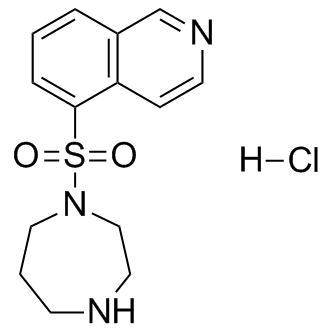| Cas No.: | 105628-07-7 |
| Chemical Name: | Fasudil hydrochloride |
| Synonyms: | HA-1077; HA1077; HA 1077; HA-1077 HCl; Fasudil hydrochloride. |
| SMILES: | O=S(C1=CC=CC2=C1C=CN=C2)(N3CCNCCC3)=O.Cl[H] |
| Formula: | C14H18ClN3O2S |
| M.Wt: | 327.827 |
| Sotrage: | 2 years -20°C Powder, 2 weeks 4°C in DMSO, 6 months -80°C in DMSO |
| Description: | Fasudil Hydrochloride is a potent inhibitor of ROCK1, PKA, PKC, and MLCK with Kis of 0.33 μM, 1.0 μM, 9.3 μM and 55 μM, respectively. |
| In Vivo: | Fasudil (30 μg) increases CBF by 50% via intra-coronary injection to dogs. Fasudil (0.01, 0.03, 0.1 and 0.3 mg/kg, bolus, i.v.) decreases MBP and increases HR, VBF, CBF, RBF, and FBF. Fasudil (1.0 ng/mL) increases cardiac output. Fasudil via i.v. produces a significant fall in MBP, left ventricular systolic pressure and total peripheral resistance with an increase in HR and cardiac output, but without obvious effect on right atrial pressure, dP/dt or left ventricular minute work in dogs[3]. Fasudil exhibits protectable effects on cardiovascular disease and reduces the activation of JNK and attenuates mitochondrial-nuclear translocation of AIF under ischemic injury[6]. Fasudil (100 mg/kg/day, p.o.) significantly reduces incidence and mean maximum clinical score of EAE in SJL/J mice immunized with PLP p139-151. Fasudil inhibits the proliferative response of splenocytes to the antigen in mice. Fasudil decreases inflammation, demyelination, axonal loss and APP positivein spinal cord of Fasudil-treated mice via p.o. administration[7]. |
| In Vitro: | Fasudil Hydrochloride has vasodilatory action and occupies the adenine pocket of the ATP-binding site of the enzyme[1]. Fasudil produces a competitive inhibition of the Ca2+-induced contraction of the depolarized rabbit aorta. Fasudil inhibits contractile responses to KCl, phenylephnne (PHE) and prostaglandin (PG) F2a[2]. Fasudil also exhibits vasodilator actions by inhibition of 5-hydroxytryptamine, noradrenaline, histamine, angiotensin, and dopamine induced spiral strips contraction[3]. In addition, Fasudil induces disorganization of actin stress fiber and cell migration inhibition[4]. Fasudil inhibits hepatic stellate cells spreading, the formation of stress fibers, and expression of α-SMA with concomitant suppression of cell growth, but does not induce apoptosis. Fasudil also blocks the LPA-induced phosphorylation of ERK1/2, JNK and p38 MAPK[5]. |

 DC Chemicals' products qualify for U.S. tariff exemptions. We guarantee no price increases due to customs duties and maintain stable supply, continuing to deliver reliable research solutions to our American clients.
DC Chemicals' products qualify for U.S. tariff exemptions. We guarantee no price increases due to customs duties and maintain stable supply, continuing to deliver reliable research solutions to our American clients.





















